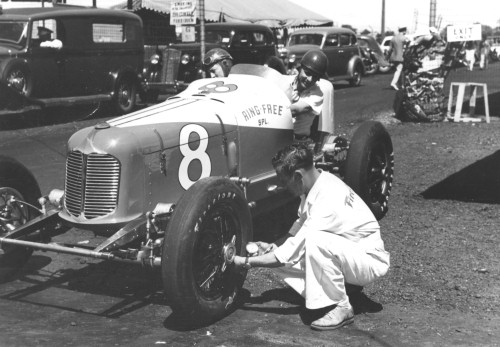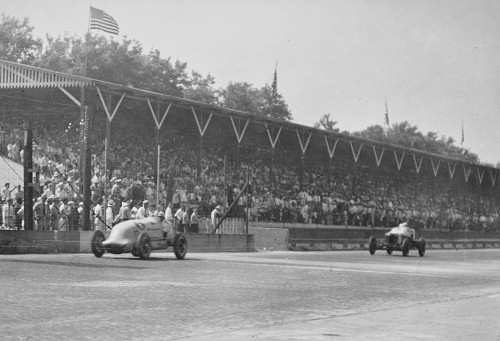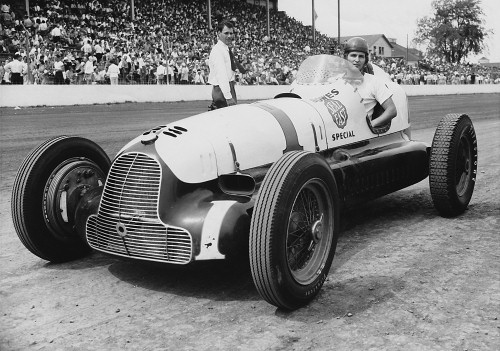The Way It Is/ Indy car racing through the Depressionby Gordon Kirby |
 It's intriguing and possibly instructive to reflect on the state of Indy car racing and the Indy 500 through the nineteen-thirties and the Depression years. Hard financial times resulted in far fewer AAA Championship races than there were in the twenties so that through most of the thirties there were only six or seven Championship races each year.
It's intriguing and possibly instructive to reflect on the state of Indy car racing and the Indy 500 through the nineteen-thirties and the Depression years. Hard financial times resulted in far fewer AAA Championship races than there were in the twenties so that through most of the thirties there were only six or seven Championship races each year.
In 1938 the AAA series hit rock bottom with only two races, the Indianapolis 500 and a dirt track race at Syracuse. Just three Championship races were run each year from 1937-1941, before WWII brought a temporary end to racing in America through 1945. During these years there were many other non-championship and non-AAA 'outlaw' races all around the country. The AAA ran its own thriving Pacific Coast Championship from 1929-'36 while numerous 'outlaw' races often were billed as 'Big Car' races and the cars featured plenty of independent engine and chassis development in the best tradition of American hot-rodding.  © Racemaker Press ~ Billy Arnold in 1930 In theory, the changes in engine formula were an attempt by the AAA to attract the country's auto makers back into Championship racing, but as the Depression took hold any such hopes vanished. The new rules became popularly known as the 'Junk Formula', but despite not achieving the AAA's goal it spawned an increasingly interesting variety of cars and engines over the following decade. In contrast to most of the nineteen-twenties where Miller and Duesenberg cars and engines had ruled the roost, there was a much wider selection of machinery at Indianapolis in 1930. Most of that year's 500 field were Millers or Duesenbergs but there were also engines from Studebaker, Stutz, Oakland, Maserati, Fronty-Ford, Buick, Chrysler and others such as Lycoming, DuPont and Clemons, all fitted to two-man chassis. Money may have been short but American ingenuity was alive and well in Gasoline Alley. The AAA's 1930 Championship season comprised eight races; the Indy 500, four board track races at Altoona (twice), Akron and Bridgeville, PA, and three dirt track races at Langhorne, Detroit and Syracuse. The new season witnessed the arrival of a fresh young star in Billy Arnold who won the 500 in convincing style aboard Harry Hartz's beautifully-prepared Summers-Miller. Arnold made his debut at Indianapolis in 1928, aged 22, finishing seventh. He came home eighth in 1929, but was the man to beat in 1930, qualifying on pole and leading all but the first two laps of the race. Arnold ran away from the field to win by more than seven minutes! Arnold won two other races that year at Altoona driving Hartz's Summers-Miller. He finished fourth at Akron in June aboard a Fronty-Ford and seventh at Bridgeville in July driving a Stevens-Miller. These results enabled Arnold to comfortably win the AAA championship from Shorty Cantlon and Bill Cummings. The following year the handsome young star played himself in a Hollywood movie. At Indianapolis in 1931 Arnold was again the man to beat, once more running away from the field and leading 155 laps until crashing on lap 162. A wheel came off the car, bounced over the retaining fence and killed a young boy playing in his front yard outside the track. Both Arnold and his riding mechanic Spider Matlock were seriously injured and he didn't start any more races that year. He came back for the 1932 500 again driving Hartz's Summers-Miller. Arnold qualified in the middle of the front row and led 57 laps before crashing on lap 60. He broke a shoulder in the accident while riding mechanic Matlock suffered a broken pelvis. That was the end of Arnold's racing career, as his distraught wife convinced him to retire.  © Racemaker Press ~ Louis Meyer in 1936 At the end of 1933, Miller's engine business was taken over by his shop foreman Fred Offenhauser in lieu of unpaid wages. By 1935 Offenhauser started building 220 cubic inch four-cylinder engines based on a Miller design. A few years later Offenhauser began to turn out 255 and 270 cubic inch four-cylinder engines that would become the company's trademark power plant, winning races from the mid 1930s through the 1960s. The four-cylinder Offy scored its first AAA Championship win in the 1935 Indy 500 with Kelly Petillo winning the race in a Wetteroth-Offy. Starting in 1934 a fuel restriction was introduced at Indianapolis with a limit of 45 gallons for the 500 miles. Oil supply for the race was also restricted to six gallons and only three gallons of fuel were allowed for the four-lap, ten-mile qualifying runs. The first of four 500s run to these restrictions was won by Bill Cummings aboard an aging front drive Miller owned by Chicago union boss Mike Boyle. Cummings was also declared the AAA Champion in 1934 with Petillo taking both the 500 and championship honors the following year. The next year, 1936, saw the arrival of the first three-time winner of the Indy 500. Louis Meyer scored his first Indy win in 1928, his second in 1933 and third in 1936. Driving a Stevens-Miller, he led 96 laps in 1936, including the last 54 as no fewer than seven drivers, including polesitter Rex Mays, ran out fuel in the final twenty laps. Meyer had started the tradition of drinking milk in victory lane at the 1933 Indy 500 when he drank a glass of buttermilk. After his third win in 1936 he drank from a milk bottle, as most race winners have done since. Meyer started a dozen Indy 500s between 1928-'39 and finished second in 1929. He also won the AAA Championship three times in 1928, 1929 and 1933. Lou ran his last 500 in 1938 and was running second with two laps to go when he hit the wall trying to catch winner Wilbur Shaw. After WWII, Meyer and Dale Drake bought Fred Offenhauser's engine-building operation and Meyer-Drake Engineering continued to manufacture the venerable Miller-based, four-cylinder Offy for more than a third of a century. The engine dominated AAA and USAC championship racing through the fifties and into the mid-sixties and enjoyed a revival in turbocharged form through the seventies.  © Racemaker Press ~ Wilbur Shaw winning the 1937 500 In 1936 teams from Alfa Romeo, Maserati and Bugatti took up the challenge and their more sophisticated road racing cars dominated the race. A big field of 45 cars started the '36 Vanderbilt Cup with Tazio Nuvolari winning easily aboard an Alfa Romeo from Jean-Pierre Wimille's Bugatti and two more Alfas driven by Antonio Brivio and Raymond Sommer. The first American finishers were Bill Cummings and Mauri Rose in seventh and eighth places, both aboard Miller-Offies. Beyond the Indy 500 and Vanderbilt Cup, there were only two other AAA Championship races in 1936, dirt races at Goshen, IN and Syracuse, NY. Mauri Rose finished second to Rex Mays at Goshen in June and won at Syracuse in September to take that year's AAA championship from Indy winner Meyer who didn't finish at Goshen and didn't enter Syracuse. The 1937 championship was taken by Indy winner Wilbur Shaw who drove his own Shaw-Offy to the first of three wins he would score in the 500. Meanwhile, the 1937 Vanderbilt Cup race was again dominated by the European teams. This time Mercedes-Benz and Auto Union sent multi-car teams with Rudolf Carraciola qualifying one of the magnificent Mercedes Grand Prix cars on the pole and Bernd Rosemeyer winning the race in an Auto Union. Richard Seaman finished second in another Mercedes while Rex Mays was the first American finisher in third place at the wheel of an Alfa Romeo Grand Prix car entered by the Bowes Seal Fast team. Fourth and fifth were Ernst von Delius's Auto Union and Nino Farina's Alfa Romeo. The two Vanderbilt revival races emphasized the wide chasm that existed between Europe's Grand Prix cars of the thirties and America's AAA Championship cars. The sport had struggled in America with no major races other than the Indy 500 but it had grown in Europe with the arrival of a series of classic Grand Prix races to compliment the original French GP and Monza's Italian GP. These included the Belgian GP at Spa, the German GP at the Nurburgring and the Monaco GP, all of which contributed to a much stronger base for motor racing in Europe. Thus following general discontent, the AAA introduced a new formula for 1938 which was identical to the latest European Grand Prix formula for 183 cubic inch (3.0 liter) supercharged engines and 274 cubic inch (4.5 liter) normally-aspirated engines. This formula would last through 1965 with a slight reduction in engine size in 1957 to 2.65 liters supercharged and 4.2 liters normally-aspirated.  © Racemaker Press ~ Wilbur Shaw in winners circle 1937 Through this time many people continued to race much-modified Miller cars and engines although an increasing number had switched to the newer Offenhauser version of the old Miller design. At Indianapolis in 1939 fifteen cars were powered by Offy engines. There were also five Millers, three Sparks engines, two each of Maserati, Alfa Romeo and Brisko, and single examples of Winfield, Duray, Lencki, Studebaker and Sampson; everything from four and six-cylinder designs to supercharged eight-cylinder engines and the V-16 Sampson. Those were lean and difficult times, but technical variety and independent thinking flourished in racing. It's sad that nothing like it exists in American racing today. For example, two notable new engines appeared in 1937 and '38; Art Sparks' six cylinder, known as the 'Little Six', and Bud Winfield's supercharged Winfield straight eight which powered the Bowes Seal Fast cars built by Myron Stevens. Both of these engines were drawn by Leo Goosen and manufactured at Fred Offenhauser's shop in California. A pair of Sparks cars and engines debuted at Indianapolis in 1938, driven by Jimmy Snyder and Ronnie Householder. The cars raced regularly over the following years and the talented Snyder finished second to Wilbur Shaw's Maserati at Indy in 1939. Two years later Ted Horn drove an Adams-Sparks to finish third in the last 500 run before America entered WWII and when racing resumed in 1946 George Robson would win the first post-WWII running of the 500 aboard one of the Sparks "Little Sixes". The supercharged Winfield engine was the last straight eight racing engine designed and built in America and the final development of Harry Miller's classic eight cylinder design. Louis Meyer drove the Bowes Seal Fast Stevens-Winfield in his last two Indy starts in 1938 and '39 and after Meyer retired Rex Mays was hired to drive the car. Mays finished second at Indianapolis in 1940 and '41, and took the AAA championship in both seasons. During those years, Mays was the man to beat with the Bowes Seal Fast Stevens-Winfield straight eight. He sat on the pole at Indianapolis in 1940, led 38 laps and finished second to Wilbur Shaw's Maserati. He led again in 1941 but had to settle for second once more, this time to the Wetteroth-Offy driven by Floyd Davis and Mauri Rose.  © Racemaker Press ~ Rex Mays at Milwaukee, 1941 Meanwhile, Wilbur Shaw established himself in 1940 as the second man to win three Indy 500s. Shaw scored his first win at Indianapolis in 1937 driving his own sleek Gilmore/Shaw-Offy before scoring back-to-back wins in 1939 and '40 aboard labor leader Mike Boyle's twin supercharged Maserati Grand Prix car. He was leading again aboard the Maserati in 1941 when a wheel collapsed and he crashed, injuring his back. Shaw's accident at the Speedway in 1941 and the arrival of WWII brought an end to his driving career. But he was a charming, outgoing man and when Eddie Rickenbacker decided to sell the derelict Indianapolis Motor Speedway after WWII, Shaw convinced Indiana businessman Tony Hulman to buy the track. Hulman appointed Shaw president and general manager and Shaw ran the 500 from 1946 until his death in an airplane crash in October, 1954. A native Hoosier from nearby Shelbyville, Indiana, Shaw is considered to be one of the most influential figures in the Speedway's history. Would that the sport enjoyed such leadership today. |
|
Auto Racing ~ Gordon Kirby
Copyright ~ All Rights Reserved |
